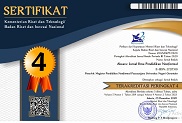Nyanyian Buaian Pada Masyarakat Kaili Tinjauan Nilai Estetika Dan Nilai Relijius
Abstract
Keywords
Full Text:
PDFReferences
Abdul Hadi, 2004. Hermeneutika, Estetika, dan Religiusitas. Esai-esai Sastra
Sufistik dan Seni Rupa. Yogyakarta. Penerbit Matahari.
Anonym“Sosial Budaya Sulawesi Tengah†dalam http://www.google.co.id/sosialbudaya-
Sulawesi-Tengah/ diakses pukul 23.45 pada tanggal 03 Januari 2015
Bagus Lorens (2000), Kamus Filsafat. PT Gramedia Pustaka Utama. Jakarta
Barthes, Roland. 1977. “The Death of the Authorâ€. New York: Hill and Wang.
Djamaris Edwar, 2002. Pengantar Sastra Rakyat Minangkabau. Yayasan Obor
Indonesia. Jakarta
Danandjaja, James. 2002. Folklor Indonesia. Jakarta: Grafiti.
_____________. 2007. Folklor Indonesia. Jakarta: Grafiti.
Endraswara, Suwardi 2009. Metodologi Penelitian Folklor. Media Presindo. FBS
Universitas Negeri Yogyakarta.
_____________,2013. Metodologi Penelitian Sastra. CAPS Center for Academic
Publishing Service. Yogyakarta.
Kutaratna Nyoman, 2009. Stilistika. Kajian Puitika Bahasa, Sastra, dan Budaya.
Yogyakarta. Pustaka Pelajar.
Koentjaraningrat. 1984. Kebudayaan, Mentalitas, dan Pembangunan. Jakarta:
Gramedia
______________. (2002). Pengantar Ilmu Antropologi. Jakarta: Aksara Baru.
Mulyana, (2004), Mengartikulasikan Pendidikan Nilai. Bandung, Alfabeta.
Maryaeni. 2008. Metode Penelitian Kebudayaan Jakarta: Bumi Aksara.
Maryati dan suryawati, 2007. Sosiologi Untuk SMA Kelas XI. Erlangga. Surabaya.
Nurgiyantoro, Burhan. 2002. Teori Pengkajian Fiksi. Yogyakarta: Gajah Mada University Press
Pudentia, 2007. Hakikat Kelisanan dalam Tradisi Lisan Melayu Mak Yong. Depok:
Fakultas Ilmu Pengetahuan Budaya Universitas Indonesia.
Rozak Abdul, dkk. 1997. Kamus Istilah Sastra. Balai Pustaka. Jakarta.
Sutopo, H.B. 2006. Metodologi Penelitian Kualitatif Dasar Teori dan Terapannya
dalam Penelitian. Surakarta: Universitas Sebelas Maret.
Tim Redaksi Kamus Besar Bahasa Indonesia. (2008). Kamus Besar Bahasa Indonesia.
Edisi III. Jakarta: Balai Pustaka.
Tarigan, Henri Guntur,1986. Prinsip-prinsip Dasar Sastra. Bandung :Angkasa
Teeuw, A. 1984. Sastra dan Ilmu Sastra. Jakarta: Pustaka Jaya.
Waluyo, 2002. Apresiasi dan Pengkajian Cerita Fiksi. Salatiga: Widya Sari Press Zulfahnur, Z.F, dkk. 1996/1997. Teori Sastra Indonesia. Jakarta: Depdikbud
DOI: http://dx.doi.org/10.37905/aksara.8.2.1193-1208.2022
Refbacks
- There are currently no refbacks.
Copyright (c) 2022 Aksara: Jurnal Ilmu Pendidikan Nonformal

This work is licensed under a Creative Commons Attribution-ShareAlike 4.0 International License.
Publisher:
Magister Pendidikan Nonformal Pascasarjana Universitas Negeri Gorontalo
Jl. Soedirman No. 06 Gorontalo 96128 e-mail: jurnalaksara@ung.ac.id
http://ejurnal.pps.ung.ac.id







